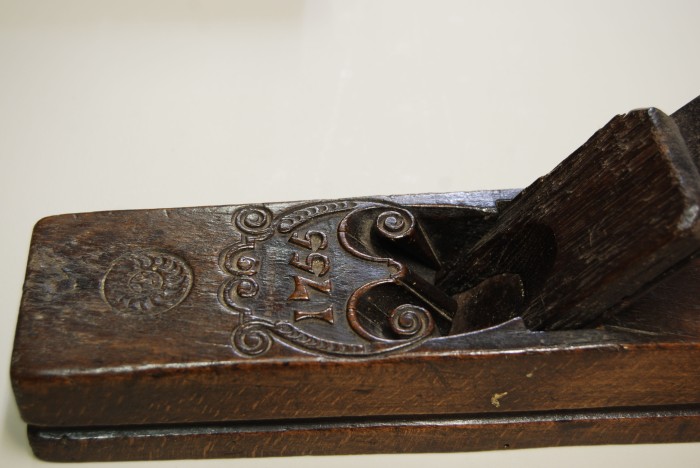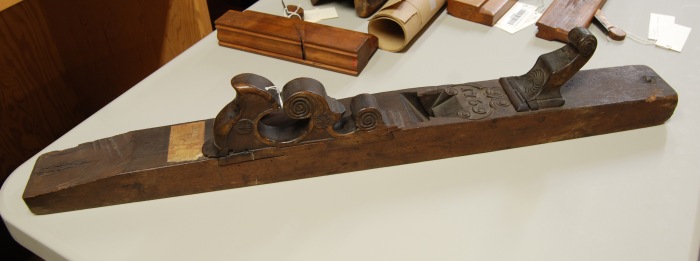I had a few minutes recently to take a quick look at a grouping of 18th-century Dutch planes. Like this:
I have always like these planes since I first saw some 20 years ago on Cape Cod. Several of this batch are panel-raising planes, most have skewed mouths. And, all are carved. Some better, some pretty good. They often are trimmed at the back end like this one. Makes handling them easier, more comfortable I guess.


This one’s got a straight mouth, longer body than the ones above. Not like a jointer, though…I’d guess about 14″.



Here’s a couple of wedges that got away from planes…

One of the original irons, quite thin. Tapered in thickness and width.

Quite thin, not like 19th-century plane irons.

Here’s some of those scroll planes – a “gerfschaaf” in Dutch. Gerrit van der Sterre says it is sometimes called a “hobbelaar” or “rocking plane.” Says the sole can be straight, hollow or rounded in cross-section, as well as straight or curved lengthwise. Thinks they are for roughing out… these are small. maybe 8″ – 10″ long. Not more…
Then the full-blown jointer plane. Munged up a bit, but still a great tool. It makes me want to make one next week – but I have to wait til I finish a bunch of other stuff!

Gerrit van der Sterre’s book is called Four Centuries of Dutch Planes and planemakers, published in Leiden by Primavera Press 2001.
Here is a plane from Randle Holme’s Academie of Armory or Blazon, 1688. Showing a Dutch-style plane, used in England. Was it an English style too? Or is it imported, or used by Dutch craftsmen working in England?








Where did you see these and what is their story? Interesting that the jointer has a horn(?) -knob(?) on it like your Mary Rose plane
I own a copy of the van der Sterre and have read it cover to cover at least twice. Very comprehensive and informative. Highly recommend it.
Besides the obvious (beautiful) ornamentation on the tote of the jointer, is there any purpose to the shape? It doesn’t appear comfortable to wrap fingers around (a la Stanley,) so maybe it’s held similar to coffin sided smoother, with a thumb in the hole? Are there other ways to hold a wooden jointer or atypical wear?
They are so beautiful. I love all things Dutch from that period. A motto of Dutch merchants at that time was ‘Quality first and profit will follow’. I think that goes for so much produced at that time in Holland.
Really nice. Thanks for posting this.
These planes are incredible. I think it does a lot for one’s standard of quality and beauty in their work to use tools of high quality and beauty. I would love to make some planes like this some day. Thanks for posting,
-Anthony
It might be helpful to put up two more Dutch plane images. I recall they are both smooth planes. One is an image you have of a 17 C plane that was used in New England. You have among your tools an identical plane probbably made in the 19th C. Tim Nagle sent this one to us from Washingtn State. It is in excellent shape. Both front and rear ends of these planes are curved for comfortable use. It is also makes it easy to flip the plane around and pull when desired. Their soles are dropped down with vertical front and rear ends so that blade depth can be adjusted by striking the front or rear drop down. This keeps the blades in good shape. Good tools travel . I wonder if some Internet fiendee could tell us if these planes are still made.
Jennie
Great looking tools!
Thanks for sharing, it made my evening more enjoyable!
Bob
I am intrigued by those scroll planes. If they arent compass (or raduis, cant remember wether compass does a concave shape, and radius convex-or vice versa?) planes, why else would they have a curved sole? Modern orthodoxy tells us that a smoothing plane MUST BE FLAT. Are all planes designed to produce a straight parallel cut? I may be deluded, but I was wondering if these scroll planes produce a scooping cut? Possibly start the plane across a section of board face with the toe down flush, and as it progresses through the pass, gradually drop the heel so that the iron enters the wood gradually, then leaves it gradually during the pass, with the heel flush at the end of the pass, so as to acheive adze like scooped surfaces? Maybe on wild grain also?
Just a thought
I love the carving on those planes, especially the dates and the scrolls. I noticed that the tote on the jointer plane also has some stamping design in the carved background. Kinda of a triangular shaped stamped design much like one used in chip carving. Nice use of rosettes also.
The last plane you show is carved, I have a set of 2 similar planes without the carvings, see https://www.woodworking.nl/showthread.php?5158-Meld-hier-je-oude-nieuwe-handgereedschap posting 2592.
Both planes have the same Iron in them with the name IOHN GREEN stamped in them.
Any idea how old they could be?
I have a small gerfschaaf with the letters IVE on it. But there’s no way to add a photo here.